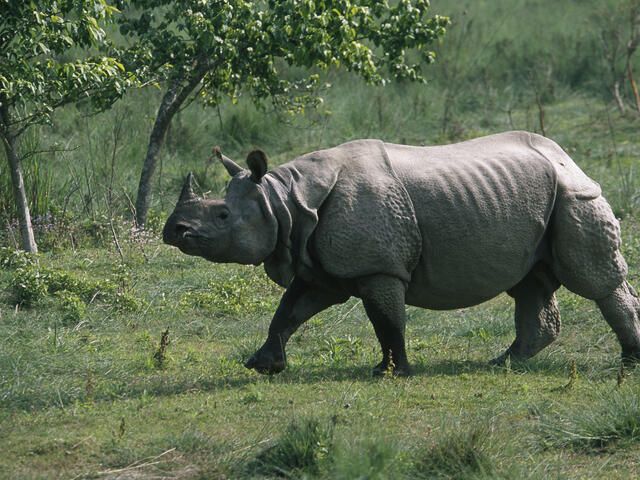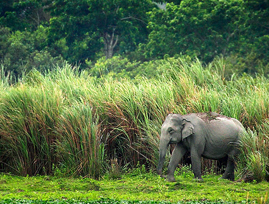
Kaziranga National Park, one of the prominent national parks of India, stands as a testament to successful wildlife conservation. Spanning across the floodplains of the Brahmaputra River, this UNESCO World Heritage Site is renowned for its significant population of the Great Indian One-Horned Rhinoceros. This article of NEXT IAS aims to study Kaziranga National Park in detail, including its location, prominent wildlife species & vegetation found here, and other related facts.
About Kaziranga National Park
- It is a National Park located in Assam.
- It is situated on the banks of the Brahmaputra River and lies between the Brahmaputra River and the Karbi (Mikir) Hills.
- Along with being one of the last unmodified natural areas in the northeastern region of India, it also boasts of being the single largest undisturbed and representative area in the Brahmaputra Valley floodplain.

Key Facts about Kaziranga National Park
- It is a part of the Eastern Himalayan Biodiversity Hotspots.
- The Diphlu River runs through it.
- The National Highway 37 passes through it.
Legal Status and Designations
| National | – It was designated as a National Park in 1974. – It was declared a Tiger Reserve in 2006. |
| International | – It was designated a UNESCO World Heritage site in 1985. – It has also been declared as an Important Bird Area by the Birdlife International. |
Key Conservation Achievements
- Kaziranga is home to around 2/3rd of the world’s Great Indian One-Horned Rhinos.
- The park has made a spectacular conservation achievement in saving the Great Indian One-Horned Rhinoceros from the brink of extinction to breeding its single largest population.

- The park has recorded one of the highest density of Tigers in the country. As a result, it has been declared as a Tiger Reserve.
- It is one of the last remaining homes of the endangered and endemic Western Hoolock Gibbon, the only species of apes found in India.
- It is one of the last homes of the critically endangered Bengal Florican.
Prominent Fauna
| Mammals | – Kaziranga is mainly known for the ‘Big Five’ species – The Great Indian One-Horned Rhino, Asian Elephant, Royal Bengal tiger, Asiatic Water Buffalo, and Swamp Deer – Other prominent mammals found are: Panthers, Sambar Deer, Hog Deer, Sloth Bears, Gaur, Capped Langur, and Hoolock Gibbon |
| Aquatic Species | – Gangetic River Dolphin are found in some of the closed oxbow lakes |
| Birds | – The park’s location at the junction of the Australasia and Indo-Asian flyway means that the park’s wetlands are an important destination for migratory bird species. – During the winter season, many migratory birds flock from Central Asia to this park. – Some prominent migratory bird species found here – Lesser White-Fronted Goose, Ferruginous Duck, Baer’s Pochard Duck and Lesser Adjutant, Greater Adjutant, Black-Necked Stork, and Asian Openbill Stork. |
Prominent Vegetation
- Wet Alluvial Grasslands occupy nearly two-thirds of the park area.
- The grasslands are interspersed with patches of Tropical Moist Deciduous Forests and Tropical Semi-Evergreen Forests.
- It is famous for its dense and tall Elephant Grasses intermixed with small swampland.

Challenges Faced
- The Poaching of Rhinos has been a serious problem.
- Seasonal flooding of the region causes many animals to migrate outside the park where they are susceptible to hunting and reprisal for crop damage.
- Shifts in river courses result in the loss of forest land.
- The perimeter of Kaziranga on three sides is adjacent to human settlements leading to challenges of illegal incursions.
- The presence of the busy National Highway 37 along the southern border of Kaziranga has brought increased settlements near the park. This disturbs free wildlife movements in this landscape.
In conclusion, Kaziranga National Park not only exemplifies the success of conservation efforts in India but also serves as a global inspiration. As a model of the delicate balance between human development and the preservation of our planet’s invaluable natural heritage, it has a lot to offer as learnings for sustainable development. Continued vigilance, adaptive conservation strategies, and other necessary steps should be taken to address the challenges faced by this protected area to maintain its ecological integrity.
Frequently Asked Questions (FAQs) on Kaziranga National Park
Where is Kaziranga National Park located?
Kaziranga National Park is located in the northeastern state of Assam, India. It is situated on the edge of the Eastern Himalaya biodiversity hotspot, along the floodplains of the Brahmaputra River.
What are the Big Five of Kaziranga?
The “Big Five” of Kaziranga National Park refers to five majestic species that are among the most prominent animal species found here. They include – The Great Indian One-Horned Rhino, Asian Elephant, Royal Bengal tiger, Asiatic Water Buffalo, and Swamp Deer.
Which river passes through Kaziranga National Park?
The Park is situated on the banks of the Brahmaputra River, and the Diphlu River passes through it.





